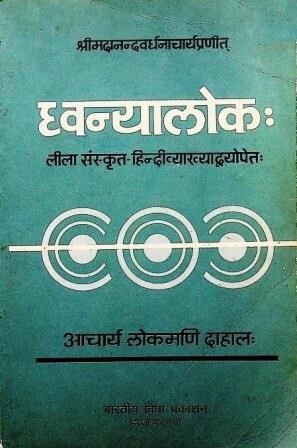

 In his work Dhvanyaloka, written in the ninth century, Anandavardhana was the first to present the philosophy of dhvani or suggestion. Although the seeds of this doctrine can be found in the hypotheses of earlier theoreticians.
In his work Dhvanyaloka, written in the ninth century, Anandavardhana was the first to present the philosophy of dhvani or suggestion. Although the seeds of this doctrine can be found in the hypotheses of earlier theoreticians.
Anandavardhana firmly advised both poets and critics to adhere to the idea, which has since come to be recognised as a crucial principle of criticism in Indian poetics.
Lokamani Dahal, Dhvanyaloka of Anand Vardhan, CC0 1.0
The erudite refer to this type of poetry as DHVANI, or “Suggestive Poetry,” where the (conventional) meaning makes itself secondary or the (conventional) word makes its meaning secondary and indicates the intended inferred meaning.
As a result, such poetry is categorised as suggestive poetry because, after the advent of the explicit meaning, the signified and indicated meanings are subordinate and assign the primary place to the tertiary or suggested meaning.
In this procedure, semantic meaning does not conflict with or impair the lyrical meaning. Instead, the proposed meaning is accessed through the semantic meaning.
According to Anandavardhana, understanding of that sense can only be attained by the explicit sense, just as the intent of a phrase is understood through the meaning of the constituent words.
The suggested meaning in this instance is “that sense,” and in a dhvanikavya, it is of utmost significance. Anandavardhana claims that “suggestion” is both the essence of all great poets' works and the most lovely poetic principle. When the suggested interpretation is less important than the poetic intention, a poem is deemed inferior in ordinary poetic parlance.
Dhvani, or symbolic content, is further defined by Anandavardhana as a poetic invention, and the various varieties of poetic endeavours are categorised by the idea of the supremacy of suggestion.
The best examples of poetic art do not confine themselves to the strict parameters set by the expressive and the expressed. It goes beyond the bounds and makes inferences about the symbolic content, which demonstrates that it is one of the mysterious allures, and this rise is likened to resonance or echo.
The Abhidha (denotation)
The Laksana (implication)
The Vyanjana (suggestion)
Anandavardhana asserts that a word possesses the power of suggestion in addition to the two powers of denotation and implication.
The other two saktis are based on Abhidha, which is fundamental. Abhidha can be characterised as the capacity of language to communicate an expression's literal or conventional meaning.
Laksana, which is the word's second power, is an indicator power. It consists of the outward manifestations of the expression that point to a deeper meaning.
The third power, or Vyanjana, means what is oblique.
To sum up, it may be claimed that Sanskrit poetry is rich in perceptions and ideas because it is a significant part of our heritage. It advanced the idea that Sanskrit poetry has the ability and depth to fully realise the artistic potential of literary works, whether they are classical or contemporary, eastern or western.
These applicational models encourage the blending and transformation of image, symbol, metaphor, rhythm, and tone with emotion and feeling. They also encourage the development of high linguistic sensitivity and the capacity for cross-cultural boundaries.
The greatest practitioner of Dhvani was Anandavardhana, a proponent of rasa. He concluded that only dhvani could convey rasa.
According to his commentator Abhinavagupta, dhvani might be used throughout the entire text, simply the meaning, or just one word.
Q1. In Dhvanyalokam, Anandavardhana addresses three primary categories of implicit sense. Explain.
Ans. Alakaara, Vastu, and Rasa are the three dhvanis.
Vastu dhvani implies a unique truth or concept. Some alankaara or figures of speech are suggested in Alankaara dhvani. Rasa is evoked in Rasa dhvani. Vastu dhvani and Alankaara dhvani can both be presented by vacyaartha, or direct meaning, and vyangyaartha, or suggestion. However, the third type of rasa dhvani's implicit sense can never be represented by the direct meaning of words.
Q2. The explanation of Dhvani provided by Anandavardhana was not accepted by many academics. Name some critics and their points of view.
Ans. Bhattanayaka, Kuntaka, Mahimabhatta, Dhananjaya, Bhoja, Rajasekhra, and Vishwanatha criticized his explanation.
They posed inquiries like, “How can Guna and Alamkara be regarded to produce beauty if they are distinct from Dhvani?”
Rasa is the primary element and the subject of poetry, according to Mammata's reasoning. To push down the dhvani, he said vakyartha rasatmakarth kavyam, establishing a connection between poetry and the rasa.
Since dhvani has no independent or cognizable existence, Mahimabhatta grouped all varieties of dhvani under the heading Anumana, the conclusion.
Q3. What do you understand by the word Citrakavya?
Ans. The category of poetry that is of a lower calibre is that which has no implied message. Poetry in the style of a portrait is referred to as citrakavya.